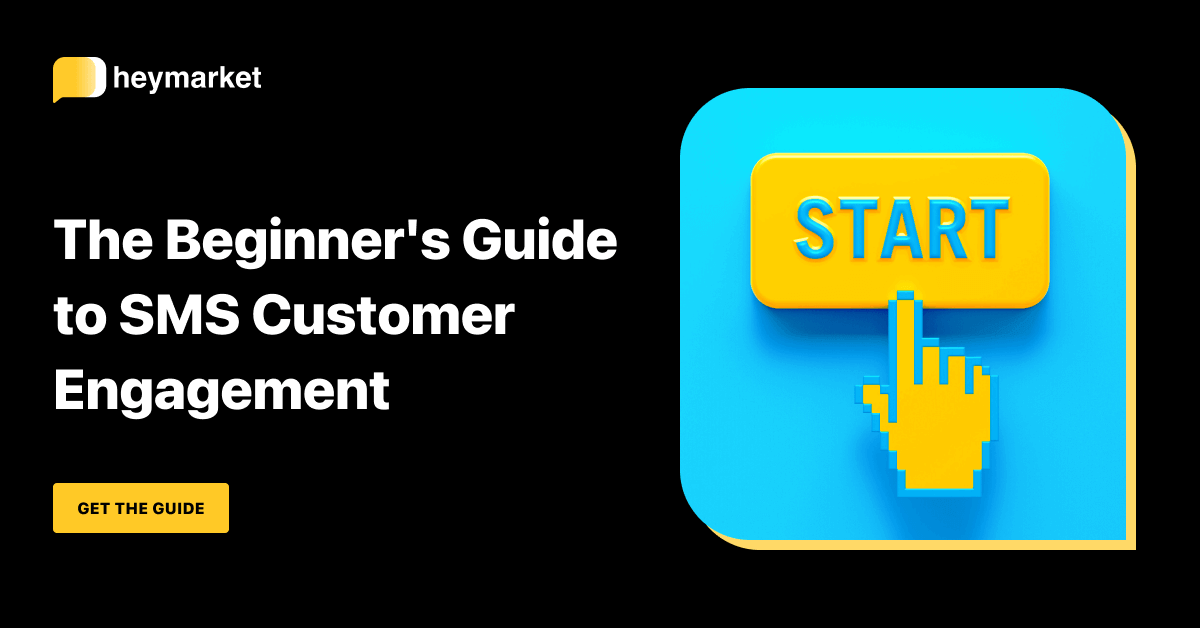
Business text messaging strategy is constantly evolving. As consumers’ needs change, so do the way teams text leads and customers. Lately, two strategies have risen to the forefront: conversational customer engagement and conversational marketing.
If you’re encountering these two strategies for the first time, they may sound identical. It’s true that they have many similarities. But they also have their own particular definitions and use cases.

Want a step-by-step look at building strong customer relationships through texting? Read our Beginner’s Guide to SMS Customer Engagement.
Get the guideWhat Is Conversational Customer Engagement?
Conversational customer engagement involves encouraging active customers to participate in person-to-person chats with customer service agents, customer care team members, or subject matter experts.
These conversations aim to either check in with or improve the customer experience. As such, conversational customer engagement content is almost always centered around customer service. Conversational customer engagement content may include:
- Order or ticket follow-ups
- Customer service surveys
- Invitations to chat with industry/product experts
Once leads or customers reply to this content, team members can begin conversations. They can offer remedies to problems and provide their expert opinions. If it’s relevant, they can also recommend relevant products or services.
First and foremost, the goal of conversational customer engagement is to improve the customer experience and build strong customer relationships. Of course, it often boosts conversions in the long run. The happier customers are, the more likely they’ll continue purchasing your products and services.
What Is Conversational Marketing?
Conversational marketing involves enticing leads or inactive customers into interacting with your content, and starting brand-focused conversations.
Conversational marketing content aims to encourage brand interest, which means it usually features CTAs for leads and customers to respond. Content may include:
- Polls and fun surveys
- Product tips or interesting use cases
- Announcements for Q&A sessions with collaborators or designers
- Information about special services (e.g., gift concierges)
Once leads and customers reply to conversational marketing content, team members can answer queries or reach out with additional questions. They can also offer insider information and recommend products or services.
The goal of conversational marketing is to encourage brand interest, get leads and customers to connect with your brand, and provide a chance for team members to make authentic case-by-case purchase recommendations. Ultimately, it’s one of the best ways to secure customers.
How do Conversational Customer Engagement and Conversational Marketing Compare?
From their definitions, it’s clear that conversational customer engagement and conversational marketing are similar and different in a few key ways. Let’s explore these comparisons.
Similarity: Focus on Personal Connections
Both strategies respond to modern customers’ demand for brands that make authentic, personal connections. Conversational customer engagement offers transparency and one-one-one service that improves the customer experience. Conversational marketing attracts new customers and conversions through interactive content and person-to-person recommendations.
Similarity: Ideal for SMS
Conversational customer engagement and conversational marketing can be in-person strategies. Asking customers their reasons for making a return can be conversational customer engagement. Handing out food samplers can be conversational marketing. But more often, people consider these strategies ideal for SMS. Because business SMS is a fast, real-time channel, it resembles in-person conversations. However, it allows team members to manage multiple conversations at once. It’s ideal for sending any and all conversational content.
Difference: Intended Audience
Conversational customer engagement and conversational marketing differ in the audience and primary intent of their content. Think of conversational customer engagement as an inbound strategy, focused on improving the experience of current or active customers. Conversational marketing is an outbound strategy, focused on promoting your brand and encouraging new conversions.
How Can Conversational Customer Engagement and Conversational Marketing Work Together?
Conversational customer engagement are both strategies that belong in your business text messaging wheelhouse.
By sending interactive marketing content and engaging in one-on-one conversations with leads, you’ll secure more customers. Then, you can ensure their experience is top-notch with customer service follow-ups and in-depth feedback sessions.
In essence, both strategies work together to attract more customers—and keep them satisfied.
Ready to boost your customer engagement strategy with business SMS? Read our Beginner’s Guide to SMS Customer Engagement.





